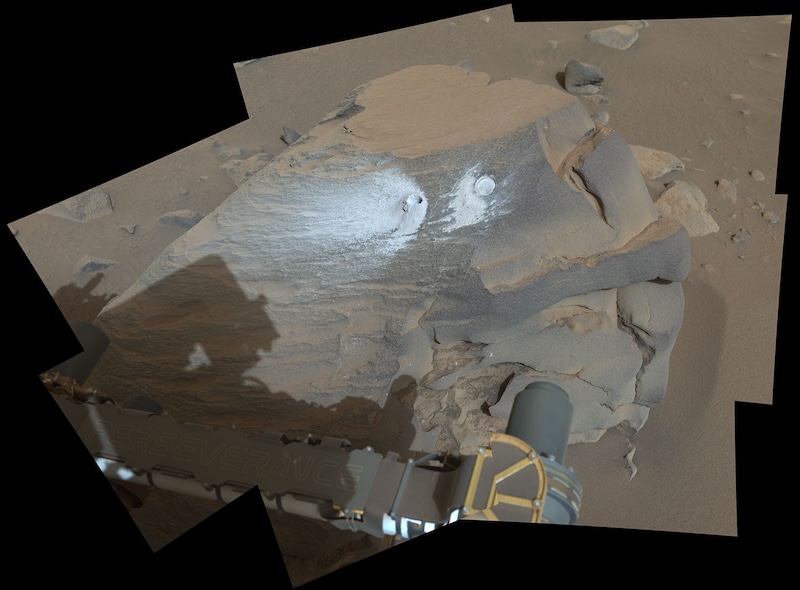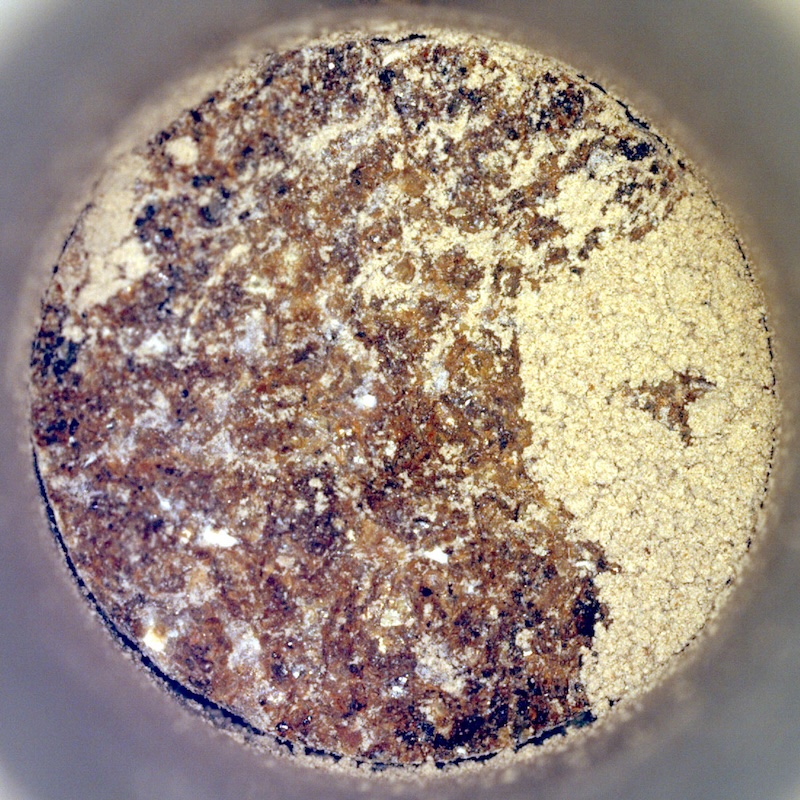
- NASA’s Perseverance rover has sampled a Mars rock called Bunsen Peak. The rock is of high interest to mission scientists. The sample is the 24th that the rover has collected so far.
- The rock likely originated from an ancient lakeshore beach, from when Jezero crater used to be a lake billions of years ago.
- Bunsen Peak is rich in carbonate and silica, meaning it is ideal for the preservation of ancient microbial life, if it ever existed.
NASA’s Perseverance rover has been exploring inside Jezero crater on Mars. Scientists say this part of Mars was once a large lake. The rover’s findings have confirmed that idea, suggesting that the region was habitable a few billion years ago, at least for microbes. Perseverance has now picked up a sample of a rock, which the scientists call Bunsen Peak. And scientists are excited about this sample! They say the rock was once drenched in water and might have originated on a lakeshore beach. Mission scientists said on April 3, 2024, that the rock is just what they’d hoped to find when the rover landed back in 2021. Carbonate and silica in the rock make it ideal to preserve traces of microscopic life.
Mars rock is ‘the kind we had hoped to find’
Perseverance has studied and sampled many different rocks during its mission so far. All of them provide valuable clues about what Mars used to be like billions of years ago. But this particular Mars rock, nicknamed Bunsen Peak, has mission scientists even a little more excited than usual. Why? Ken Farley is the project scientist for Perseverance at Caltech in Pasadena, California. As he explained:
To put it simply, this is the kind of rock we had hoped to find when we decided to investigate Jezero crater. Nearly all the minerals in the rock we just sampled were made in water; on Earth, water-deposited minerals are often good at trapping and preserving ancient organic material and biosignatures. The rock can even tell us about Mars climate conditions that were present when it was formed.
Perseverance has already found an abundance of organic compounds in rocks before. But this type of rock is especially good at preserving them, and even traces of life itself. This makes the samples obtained from the rock some of the most valuable so far in the mission.

An unusual rock from an ancient Martian beach
Mission scientists said that the rock likely originated on a beach, the shoreline of the ancient lake. They named the rock Bunsen Peak, after the mountain peak landmark in Yellowstone National Park. Even before analysis of the sample itself, which they named Comet Geyser, the mission team took notice of this interesting rock. About 5.6 feet (1.7 meters) wide and 3.3 feet (one meter) tall, it stood out from the surrounding landscape. One side had a rougher texture while the rest was smoother and fragmented in appearance.
It also wasn’t as dusty as rocks that are flatter, making it easier to analyze and obtain the sample with the rover’s drill. The rover studied the rock’s surface with its SuperCam spectrometers and X-ray spectrometer called Planetary Instrument for X-ray Lithochemistry (PIXL). Perseverance then ground (abraded) a small portion of the surface of the rock and re-analyzed it. The rover did this before it used its drill to obtain the rock core sample close to the abraded area.
Carbonate and silica could preserve traces of ancient microbial life
The initial analysis results were intriguing. Bunsen Peak is composed of at least 75% carbonate grains. Nearly pure silica binds the grains together. Why is this significant? As Sandra Siljeström, a Perseverance scientist from the Research Institutes of Sweden (RISE) in Stockholm, Sweden, explained:
The silica and parts of the carbonate appear microcrystalline, which makes them extremely good at trapping and preserving signs of microbial life that might have once lived in this environment. That makes this sample great for biosignature studies if returned to Earth. Additionally, the sample might be one of the older cores collected so far by Perseverance, and that is important because Mars was at its most habitable early in its history.
The Bunsen Peak sample is the 24th overall that Perseverance has collected so far. Of the sample tubes, 21 have rock cores, two contain regolith (broken up rock and dust) and one is a sample of atmospheric gases. It is also now the 3rd one collected while exploring the Margin Unit, a geologic area along the inner edge of Jezero crater’s rim.
Meet the Mars samples: Comet Geyser (Sample 24). Perseverance obtained this rock sample, named Comet Geyser, from the rock Bunsen Peak. Video via NASA/ JPL-Caltech/ MSSS/ JHU-APL/ Purdue/ USGS/ YouTube.
Mars rock provides more evidence for ancient lake
The findings support the hypothesis that a lake once filled Jezero crater. Perseverance has already found other abundant evidence for that scenario as well. In fact, it has been studying an ancient delta – just like deltas on Earth – where river water once broke through the crater wall and emptied into the crater. Briony Horgan, a Perseverance scientist from Purdue University in West Lafayette, Indiana, said:
We’re still exploring the margin and gathering data, but results so far may support our hypothesis that the rocks here formed along the shores of an ancient lake. The science team is also considering other ideas for the origin of the Margin Unit, as there are other ways to form carbonate and silica. But no matter how this rock formed, it is really exciting to get a sample.
Next, Perseverance is making its way to the westernmost portion of the Margin Unit. In particular, a location nicknamed Bright Angel is of interest to the science team. It may provide the first encounter with the much older rocks that make up the crater rim. Then, the rover will move to the top of the crater rim, which will take several months.
Bottom line: NASA’s Perseverance rover sampled an unusual Mars rock called Bunsen Peak. It is rich in carbonate and silica and likely came from an ancient lakeshore beach.
Read more: Perseverance rover reveals history of ancient habitable lake











